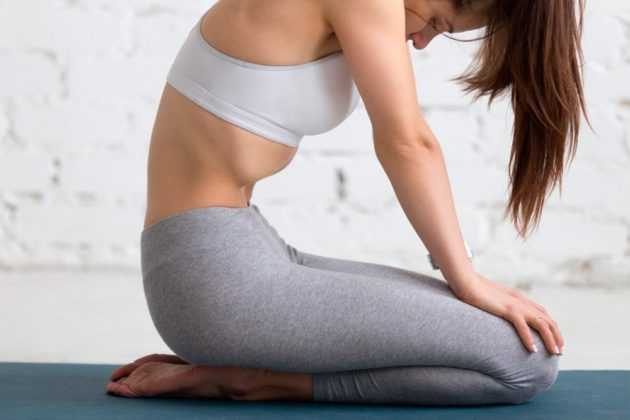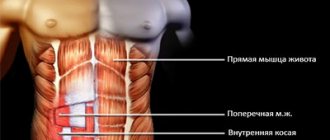Is it worth performing a “vacuum” on critical days?
The essence of the exercise is that after maximum exhalation, the chest is straightened with the stomach due to the intercostal muscles, thereby simulating inhalation. In this case, the stomach “sticks” to the spine and remains in this position for some time, comfortable for the person performing the exercise. Among the advantages of this exercise is the ability to perform it at any time, anywhere: at home, at work, in transport, sitting, standing, lying down, resting on your hands.
The benefits of a vacuum, in addition to improving your figure, are that:
- Visceral fat burns more actively;
- Digestion improves, constipation is eliminated;
- metabolism accelerates;
- venous outflow from the lower extremities improves;
- respiratory muscles are trained;
- microcirculation improves.
Despite its simplicity and accessibility, a vacuum state in the abdominal cavity is contraindicated in some situations. Among them:
- peptic ulcer of the stomach and duodenum;
- diseases of the cardiovascular system;
- surgeries on the abdominal cavity and pelvic organs (6 months);
- hiatal hernia;
- increased intracranial pressure;
- lung diseases;
- thrombosis;
- acute inflammatory or exacerbation of chronic diseases.
A special question arises when performing the exercise on critical days.
Any clear categorical answer will not be correct. The menstrual cycle of a healthy woman is variable, just as weight gain these days occurs differently for each person. Normally, the duration of menstruation ranges from 2-3 to 5-7 days. They occur in 21 - 35 days. In a healthy woman, menstruation is practically painless; minor nagging pain may be observed before or on the first day of menstruation. Normal blood loss is between 50-150 ml.
If a healthy woman’s well-being is not affected during her period and she does not want to interrupt her training, there is no reason to prohibit the vacuum. You need to focus on the sensations after completing the exercise. If the exercise is not accompanied by pain or increased bleeding, it is not necessary to interrupt training. If any discomfort, pain or increased bleeding occurs, you should avoid performing a vacuum on these days.
It is more correct, after deciding to engage in yoga practices, to undergo a consultation with a gynecologist to identify gynecological pathologies and consult with a yoga therapist, since the answer to the question of whether it is possible to do a vacuum during menstruation is individual.
Many gynecologists believe that against the background of training, irregular menstruation is restored, PMS and painful periods stop. This is due to improved blood supply to organs that are part of the menstrual cycle regulation system and normalization of hormonal balance. However, it is better for such patients to refrain from using a vacuum during their critical days.
Some useful tips
Not everyone does a stomach vacuum correctly. Consider these tips to learn and do it with maximum effect:
- For beginners, it is best to start by performing the exercise while standing, then you can make it more difficult when you master the technique.
- It is important to master the correct breathing process: exhale, then inhale briefly and deeply through your nose, and exhale sharply through your mouth, completely releasing all the air from your lungs.
- You may find it difficult to hold your breath for a long time: no problem, you can take small breaths through your nose while you hold the vacuum.
- Try to pull your stomach not only straight, but also upward, pulling it towards the diaphragm.
- Retraction is always done while exhaling.
- To maximize tension on the transverse muscle, as you inhale, release your stomach slowly, and preferably not all the way.
- The exercise is always done on an empty stomach, in the morning - immediately after sleep, and in the evening - before going to bed, or at least two hours after dinner.
- If something hurts after pulling in, stop and rest. Perhaps you are doing something wrong. Like any other exercise, it can bring not only benefits, but also harm, so carefully study the technique. It shouldn't hurt a healthy person.
- Try to hold the vacuum in your stomach for 15 seconds, do 10-15 repetitions, 2-3 approaches.
Why can't you do a vacuum during menstruation?
If there is the slightest deviation in the menstrual cycle, a vacuum during menstruation is not recommended. In order not to cause harm to the female body, vacuum is prohibited in the following cases:
- hyperpolymenorrhea;
- acyclic uterine bleeding;
- adenomyosis;
- ovarian cysts and cystomas;
- uterine fibroids;
- tubo-ovarian inflammatory formations;
- oncological diseases;
- uterine polyps and hyperplastic processes in the endometrium;
- pregnancy at any stage;
- postpartum period the first month and a half.
The main danger of exercise on critical days is that increased blood supply to the abdominal and pelvic organs provokes increased spotting or bleeding. The reason is precisely this (increased organ perfusion), and not that abdominal tension is transmitted to the muscles of the uterus. Moreover, the classic vacuum is not accompanied by tension in the abdominal muscles. If there is an inflammatory process, it may spread.
Motivate yourself
To reinforce the text material, watch this useful video from the Workout channel - stay in shape:
If nature has not rewarded you with a thin waist and flat stomach, there is a way out. All you need is persistence and proper execution of the exercise. Go to the goal. Don't cut yourself any slack. Within a week, having noticed the result, you will not force yourself, but will also increase the number of exercises.
From this article you will learn what contraindications there are for abdominal vacuum, and whether such a fashionable exercise is recommended for everyone today.
Surely each of you sucks in your stomach at least once a day to look thinner, slimmer, more toned. (even now you have 100% done it). Girls, passing by handsome guys, try as hard as they can to suck in their stomachs, and their faces at this moment have expressions of tension and unnaturalness.
The struggle with the stomach is constantly going on, heaps of exercises, diets, and procedures are being created.
Nowadays, those suffering from a flat stomach are caught up in the new exercise “abdominal vacuum” or “abdominal vacuum” . Of course, the exercise is far from new, especially for those who practice yoga. The exercise is actively promoted on thematic forums, blogs, and Instagram accounts of fitness gurus.
Performing this exercise promises you fabulous results, gaining a flat stomach and long-awaited treasured abs in a short time. A kind of panacea, a universal super remedy.
A lot of information has been written about the benefits of this exercise, but for some reason few people are interested in contraindications. Although, before performing any exercise, it is important to familiarize yourself with the list of diseases for which it is strictly contraindicated to engage in a specific exercise.
“abdominal vacuum” exercise is associated with an active impact on the abdominal organs. When performing this exercise, the abdominal organs are compressed, creating negative pressure in the abdominal cavity. In this regard, there may be unpleasant consequences if a person has a number of diseases.
Possible negative consequences
Among people who study yoga practices, there is an opinion that yoga is not a healing technique; it is intended exclusively for healthy, physically strong people. The vacuum does not cause tension in the abdominal muscles, but creates negative pressure in the abdominal cavity, and the organs are pulled upward. This effect may be temporary, and as a result the person receives permanent prolapse of the internal organs.
On topic: Super effective abdominal exercises
Getting interested in any practice should begin with consultation with a specialist. The principle “Do no harm!” is also relevant in this case.
Source
Operating principle
The Abdominal Vacuum exercise strengthens the surrounding muscle, which is responsible for its tightness and supports the internal organs, preventing them from sagging. At the same time, other muscle groups also work, there are four in total:
- Straight;
- External obliques;
- Internal obliques;
- Transverse.
During any training, they are all involved, it’s just a matter of emphasis and strength of development. The rectus and oblique muscles are responsible for the abs, and the transverse muscle is responsible for reducing the volume of the abdominal cavity.
This does not mean that regular abdominal exercises are not needed for the waist, they form a beautiful relief, but in order to remove the belly, you need to pump up the transverse muscles. They do not give any relief and are invisible on the body, but you will see the effect yourself.

The benefits and harms of vacuum exercises for a woman’s body
Most women constantly monitor their appearance: they want to be slim, fit and beautiful. A lot of different physical activities are used for this. They can be done at any age, with any physical fitness. To determine whether it is possible to do a abdominal vacuum during menstruation, it is necessary to consider the positive and negative aspects of this complex.

The main benefits are as follows:
- Effective for weight loss.
- The waist size decreases, in contrast to the use of standard tasks, where the abdominal muscles are pumped up.
- Visceral fat, which envelops the internal organs, is burned. Thanks to this, the body begins to function better.
- The digestive process improves.
- Metabolism accelerates.
- A person trains proper breathing, thanks to which the entire body is saturated with oxygen.
- Posture is corrected.
- Vigor and strength come.
The technique is not without possible harm to the body. It is not suitable for abdominal training in case of gastrointestinal diseases, heart problems, heavy menstruation and pregnancy. If you have a stomach ulcer, the technique is contraindicated.
You can learn more about stress during menstruation from the video
When should you not exercise?
We have already figured out how vacuum is useful, but like any exercise, it has some contraindications:
- Lung diseases;
- Exacerbation of a chronic or infectious disease;
- Cardiovascular diseases;
- Inflammation or ulcers in the gastrointestinal tract.
Important points for girls and women
Doctors categorically prohibit doing the exercise during menstruation and pregnancy, since the uterus is already in good shape. There are often questions about whether a girl can have a vacuum in her stomach during her period.
We answer: it is highly not recommended, since tension in the lower pelvic area can provoke increased bleeding. Wait a few days.
But after childbirth, vacuum gymnastics is even useful, as it allows a woman to quickly restore muscle tone and strengthen the muscles of internal organs. Of course, you need to start simple and small, only in a lying position and with your arms outstretched to the sides, and monitor your condition, but if everything is in order, your stomach will tighten in a short time.
Is it worth performing a “vacuum” on critical days?
The essence of the exercise is that after maximum exhalation, the chest is straightened with the stomach due to the intercostal muscles, thereby simulating inhalation. In this case, the stomach “sticks” to the spine and remains in this position for some time, comfortable for the person performing the exercise. Among the advantages of this exercise is the ability to perform it at any time, anywhere: at home, at work, in transport, sitting, standing, lying down, resting on your hands.
The benefits of a vacuum, in addition to improving your figure, are that:
- Visceral fat burns more actively;
- Digestion improves, constipation is eliminated;
- metabolism accelerates;
- venous outflow from the lower extremities improves;
- respiratory muscles are trained;
- microcirculation improves.
Despite its simplicity and accessibility, a vacuum state in the abdominal cavity is contraindicated in some situations. Among them:
- peptic ulcer of the stomach and duodenum;
- diseases of the cardiovascular system;
- surgeries on the abdominal cavity and pelvic organs (6 months);
- hiatal hernia;
- increased intracranial pressure;
- lung diseases;
- thrombosis;
- acute inflammatory or exacerbation of chronic diseases.
A special question arises when performing the exercise on critical days.
Any clear categorical answer will not be correct. The menstrual cycle of a healthy woman is variable, just as weight gain these days occurs differently for each person. Normally, the duration of menstruation ranges from 2-3 to 5-7 days. They occur in 21 - 35 days. In a healthy woman, menstruation is practically painless; minor nagging pain may be observed before or on the first day of menstruation. Normal blood loss is between 50-150 ml.
If a healthy woman’s well-being is not affected during her period and she does not want to interrupt her training, there is no reason to prohibit the vacuum. You need to focus on the sensations after completing the exercise. If the exercise is not accompanied by pain or increased bleeding, it is not necessary to interrupt training. If any discomfort, pain or increased bleeding occurs, you should avoid performing a vacuum on these days.
On topic: Pump up abs like Tyson
It is more correct, after deciding to engage in yoga practices, to undergo a consultation with a gynecologist to identify gynecological pathologies and consult with a yoga therapist, since the answer to the question of whether it is possible to do a vacuum during menstruation is individual.
Many gynecologists believe that against the background of training, irregular menstruation is restored, PMS and painful periods stop. This is due to improved blood supply to organs that are part of the menstrual cycle regulation system and normalization of hormonal balance. However, it is better for such patients to refrain from using a vacuum during their critical days.
Common myths about the vacuum exercise
Many people know that the “vacuum” exercise is a kind of remake of the yoga Uddiyana bandha, or abdominal lock. In the vastness of the Runet, it is actively presented as a magical exercise for the abdomen - they say it trains the abs and helps you lose weight; It is useful for everyone, it is recommended to do it as often and for as long as possible.
In order to dispel a number of myths regarding Vacuum, I suggest you remember the generally accepted technique for performing Uddiyana Bandha. The technique is performed by holding the breath after an empty exhalation - standing, sitting or lying down. Take a calm breath, then exhale as completely as possible, and then imitate an inhalation with your chest - spread it wide with the help of the intercostal muscles.
The stomach is relaxed. At the moment when a false inhalation is performed while holding the breath, due to the difference in pressure it is pulled up following the diaphragm. At the very beginning, you can help this by pushing it a little with your muscles, but after that it stretches and seems to stick to the spine.
The more you exhale and the wider you expand your chest after this, the more pronounced the feeling of a stuck belly will be.
This position is held for a comfortable amount of time, after which imitate exhalation with your chest and inhale smoothly and calmly.
Myths
Vacuum can be performed by everyone and always.
If you are pregnant, have your menstrual period or have not yet completed postpartum discharge, if you have scanty, rare or sometimes missing periods, if you have cysts, polyps, fibroids, endometriosis or other neoplasms, any acute and inflammatory processes in the abdominal organs and pelvic cavity, as well as a tendency to constipation - before mastering Vacuum/Uddiyana Bandha, you should consult with an experienced yoga therapist.
You can do it right after giving birth.
You need to wait until the postpartum discharge is complete. A vacuum can trap lochia in the uterine cavity and thus increase the risk of inflammatory processes. On average, you will have to wait from 6 to 8 weeks.
Will remove belly fat after childbirth.
The “big secret” is that a couple of months after giving birth, the belly will become much smaller or even “go away” without
Vacuum, simply because organs and tissues undergo gradual involution, this is physiology.
Just during this time, the uterus decreases to its previous size and weight, and the abdominal muscles themselves partially restore their tone. This is an ideal situation, but the body has self-healing mechanisms. It can do without a vacuum.
The vacuum trains the abdominal muscles.
If the Vacuum is performed technically correctly, the abdominal muscles do not contract! They stretch, and the abdomen rises and “sticks” due to the difference in pressure between the chest and abdominal cavity and the expansion of the chest by the force of the external intercostal muscles.
The contents of the abdomen are sucked upward following the diaphragm, much like liquid that is drawn in by a syringe when we lift the plunger. The abdominal muscles remain relaxed, so it is essentially impossible to strengthen them with this exercise. The flat stomach effect is temporary.
The organs rise, but it is also easy, in the absence of special muscle training, for them to return back, you just have to stop doing the Vacuum a hundred times a day.
Helps with diastasis.
Vacuum itself will not affect the situation with muscle divergence.
To take control of diastasis, you need, firstly, to seriously and systematically strengthen the deep muscles, and secondly, as we do, for example, in the “YogaMammi” program, to restore the coordinated work of the deep and superficial muscles of the body during moments of stress.
By definition, a vacuum does not train the abdominal muscles, so it cannot, even with all the desire, be a specific exercise for correcting diastasis. In the bodybuilding environment, in turn, there is an exercise that is very similar in appearance, but fundamentally different in essence, which just trains the transverse abdominal muscle in a static mode.
The trick with the effect of training the transverse muscle is that if you do Uddiyana incorrectly, then the abdominal muscles will help and, accordingly, in a sense, train.
But if you do Uddiyana efficiently and follow the technique, then there will be no talk about training the transverse abdominal muscle.
I am in favor of separating flies from cutlets. And if you want to work on the transverse abdominal muscle, then do exercises specifically for it - in yoga, for example, this is Kapalbhati breathing. And if you love “vacuum”, then do it correctly and technically and get your benefit from it.
What are the benefits of practicing Uddiyana Bandha and other vacuum techniques?
- Affect the functioning of internal organs.
How? They improve the flow of arterial blood and enhance the outflow of venous blood. Stimulate intestinal motility and the secretion of bile from the gallbladder, the production of digestive juices. In this regard, they are good for atonic constipation, as they will help move the intestinal contents “towards the exit”. This is especially true for mothers after childbirth in the case of the so-called “lazy bowel” syndrome. - Agnisara-dhauti, Uddiyana-bandha and Nauli train the external intercostal muscles
. These are the muscles of inhalation, so regular practice of these techniques will help in mastering various breathing exercises, and will also lead you to long-term fixations of holding your breath with inhalation, in other words, will help you practice pranayama - “Dynamic” abdominal manipulations - Agnisara and Nauli - improve the delivery of oxygen to tissues.
The mechanism here is as follows: they are performed while holding your breath
after
exhaling. The carbon dioxide content in the blood increases, which in turn increases microcirculation in tissues and organs. This means that the flow of nutrients and everything that stimulates the processes of healing and renewal increases. - Powerful effect on venous outflow.
When performing vacuum techniques, negative pressure in the chest causes venous blood to more actively rush to the heart. The positive effect of Uddiyana, Agnisar and Nauli on varicose veins of the pelvis and legs is associated with this suction effect - Related to the previous point is the recommendation to regularly do Uddiyana, Agnisara and Nauli for so-called functional disorders of the menstrual cycle - when there are no obvious problems at the organ level, but there are dysregulation on the part of the central nervous system, and this, in turn, causes an imbalance at the hormonal level. By doing vacuum techniques, we prevent stagnant processes in the pelvis
and indirectly help restore the cycle with functional dysmenorrhea, including PMS and painful periods
These are, of course, very general recommendations. In practice, you have to deal with unexpected effects of habitual exercises, so if you are in doubt whether or not you can do vacuum techniques or want to get the maximum benefit from your classes, contact an experienced yoga therapist.
Popular on the topic:
A guide to yoga studios in your city
We've rounded up the best places to practice yoga in your city.
Find your Asana
Source: https://yogajournal.ru/blogs/mariya-khavkina/rasprostranennye-mify-ob-uprazhnenii-vakuum/
Why can't you do a vacuum during menstruation?
If there is the slightest deviation in the menstrual cycle, a vacuum during menstruation is not recommended. In order not to cause harm to the female body, vacuum is prohibited in the following cases:
- hyperpolymenorrhea;
- acyclic uterine bleeding;
- adenomyosis;
- ovarian cysts and cystomas;
- uterine fibroids;
- tubo-ovarian inflammatory formations;
- oncological diseases;
- uterine polyps and hyperplastic processes in the endometrium;
- pregnancy at any stage;
- postpartum period the first month and a half.
The main danger of exercise on critical days is that increased blood supply to the abdominal and pelvic organs provokes increased spotting or bleeding. The reason is precisely this (increased organ perfusion), and not that abdominal tension is transmitted to the muscles of the uterus. Moreover, the classic vacuum is not accompanied by tension in the abdominal muscles. If there is an inflammatory process, it may spread.
Nutrition for endometriosis
Diet will not cure endometriosis, but it will help alleviate symptoms and slow the progression of the disease. It is recommended to adhere to the following rules:
- Meals should be frequent, fractional - in small portions 5-6 times a day. Do not overload the digestive tract;
- From the diet you need to exclude foods that increase the production of estrogen: legumes, nuts and seeds (including flax seeds), white cabbage, mushrooms, seafood. It is necessary to limit the consumption of vegetable oil, dairy products, some fruits (peaches, apricots);
- Alcohol is prohibited, especially beer - it is rich in phytoestrogens. Sometimes you can afford good wine;
- It is not recommended to drink coffee - it increases estrogen production and changes tissue sensitivity. Many women note that frequent drinking of coffee increases pain during menstruation and on other days of the cycle. Don’t get carried away with strong tea and cocoa;
- It is worth adding foods that suppress the production of prostaglandins to your diet. If prostaglandin synthesis is reduced, pain decreases. This is primarily fish, fresh vegetables and fruits, and grain crops.
With endometriosis, a woman’s menu must include fresh vegetables and fruits, excluding those foods that increase the production of estrogen.
The goal of nutrition for endometriosis is to eliminate estrogen-producing foods and prevent weight gain. But you shouldn’t get carried away with strict diets. It is better to seek help from a nutritionist. The doctor will select an appropriate diet and help cope with the symptoms of the disease.
Massage for pain
Pain during menstruation is called algomenorrhea. It is considered a deviation from the norm. When it appears, you need to see a gynecologist and identify the cause that provokes the pain. If the diagnosis has already been established, then you can resort to those procedures that are not contraindicated.
Abdominal massage for algomenorrhea allows you to stabilize the patient’s condition and relieve her of pain in cases where it is associated with swelling of the soft tissues, compression of nerve endings and fluid stagnation. In all other cases, pain cannot be relieved in this way.
Massaging the abdomen during menstruation is strictly contraindicated if the pain is caused by endometriosis, uterine fibroids, cervical deformation, etc. obstruction of the fallopian tubes, hormonal deficiency, delayed release of the egg from a mature follicle - these are all conditions that require the help of a gynecologist, not a massage therapist. You should not hope that manual intervention will help with the pain associated with obstruction of the fallopian tubes. Of course, it is possible to cure adhesions and scar deformation with the help of manual therapy and massage in particular, but only with a completely different approach.
The patient should see a doctor on other days of the cycle. The doctor will conduct an examination and develop an individual course of manual therapy. After its passage, adhesions and scar deformation can be eliminated. In the future, this will lead to the fact that pain will not develop during menstruation. This problem cannot be solved quickly, in a few massage sessions.
How is a stomach vacuum useful?
With the help of uddiyana bandha, internal organs are massaged, better blood supply occurs, and the body is renewed.
With regular training, the abs acquire a beautiful shape, a person is no longer bothered by constipation, and sleep improves.
Vacuum abdominal retraction can be done as an independent exercise, in addition to the main training for various muscle groups.
You might also be interested in learning about the plank exercise. A properly performed plank stance helps strengthen muscles, improve and stabilize posture, and as a result, eliminate back problems.
Why is the vacuum exercise useful, the muscles involved?
The cause of a hanging belly is excess visceral fat and poorly developed transverse abdominal muscles.
The vacuum strengthens the transverse and multifidus abdominal muscles; these are the internal muscles that are responsible for the thinness of the waist, the retraction of the abdomen and the support of the internal organs. Women acquire the desired X shape, and men, V.

Abdominal muscle anatomy
How to do the vacuum exercise correctly?
Vacuum technique:
- We take the starting position: put our feet shoulder-width apart, hands on our hips;
- We fill our lungs with air as much as possible. We inhale through the nose. Exhaling, we strive to bring the anterior abdominal wall closer to the back;
- We perform for about 20 seconds, then inhale and bring the stomach to the starting position.
To enhance the effect of the exercise, you should pay attention to the following points:
- For beginners, it is better to do the workout standing or lying down;
- During the exercise, you can use breathing according to the bodyflex program: powerful exhalation, rapid inhalation through the nose, exhale again through the mouth;
- When exhaling through the mouth, we free the lungs from oxygen;
- We help ourselves by taking a series of breaths through the nose;
- We visualize our navel and spine, strive to connect them;
- We do the retraction while exhaling;
- When inhaling, do not lower your stomach sharply down, perform the action at a slow pace and not all the way;
- Muscle contractions must last at least 15 seconds;
- You can perform uddiyana bandha both in the morning, before the first meal, and before bed;
- During the lesson, perform 2-3 approaches, repeat up to 15 times, the isometric contraction time is from 15 seconds.
On topic: How couples pump up their abs
Vacuum is the best exercise for the abdomen
What is a belly vacuum and how to perform it?
Useful properties of exercise. What muscles does abdominal vacuum train, and why can’t everyone do it? Read the answers to these questions in this article. Excess weight around the waist is a problem that even non-obese people face. Intense workouts burn calories, eliminating fat deposits over a long period of time. But the vacuums exercise shapes your waist much faster with minimal physical exertion, without requiring long sessions in the gym with weights or grueling cardio.
Properties
The Abdominal Vacuum exercise provides a beneficial effect on the body:
- increases the power of transverse abdominal muscle fibers;
- eliminates abdominal sagging;
- removes sagging internal organs;
- reduces back pain; narrows the waist;
- reduces the volume of visceral fat deposits concentrated around organs.
The workout is suitable for people who are not overweight, but have an elongated stomach. To perform the exercise we do not need additional sports equipment.
Vacuuming the abdomen takes minimal time and helps you learn to control your abdominal muscle fibers. During the exercise, the internal organs are massaged and work better.
The exercise visually makes the chest wider, which is why it is popular among bodybuilders.
The results of the abdominal vacuum can be seen after two weeks: the abs take on a toned shape and the abdominal muscles become stronger. With constant performance of the exercise, the load on the spinal column is reduced and the posture is straightened. For this reason, abdominal training is relevant for professional athletes, ordinary people, and women after childbirth.
What muscles are trained?
Vacuum is an exercise that comprehensively involves the muscles of the torso. The main load during training is placed on the large straight transverse and lumbar muscles. They are located under the straight and oblique muscle fibers of the abdomen. Responsible for controlling the depth of breathing during strength training. Training these muscles helps improve your performance in the squat and bench press.
The described groups of muscle fibers are rarely pumped and lag behind even in athletes. However, with their help, the explosive strength necessary to improve physical performance is developed.
Abdominal vacuum exercise is intended for training:
- Torso. More precisely, the following muscle groups are involved:
- The abdomen is straight, external, as well as internal oblique.
- buttocks – medium, small, and adductor.
- Back – extensors.
- The loin is square.
- Blades. List of muscles involved:
- anterior serratus (Musculus serratus anterior);
- diamond-shaped: large and small;
- lower trapezius (Musculus trapezius).
- Shoulders The following muscle groups are pumped: 1 – pectoralis major, 2 – deltoids, 3 – rotators.
- Hand. The triceps are being pumped.
The rectus muscles form the relief of the abdomen, and the transverse muscles prevent its protrusion. The vacuum helps to work them out, increasing the visibility of the cubes. If you do not load the transverse muscle, including special exercises in the training complex, this can provoke a gradual increase in abdominal volume, despite constant strength training.
Learning to do the exercise correctly
Even experienced athletes do not always know how to make a vacuum. The effectiveness depends on the duration of repetition. The optimal time for one isometric squeeze is one to two minutes.
The abdominal vacuum exercise can be done in three ways:
- Lying down. In the initial position, the legs are bent at the knees, the arms are placed along the body or spread to the sides. We relax and exhale slowly until there is no air left. The abdominal muscles are drawn in to maximum depth, and breathing is held. After 20 seconds, take a leisurely breath. Then repeat - breathing stops again for the same time. At the end of the repetition, the lungs are gradually filled with oxygen, and the body relaxes. The back remains level throughout the entire workout.
- Sitting. The palms rest on the knees, and the legs are placed at a 90-degree angle. Exhale slowly, after which the tension is held for 30 seconds. After this time, a gradual inhalation is performed. The exercise is repeated 3 times. Attention: if you feel dizzy, the duration of holding your breath is reduced.
- Standing. This position offers two options: with a straight stance and a tilted body forward. The second method is used by bodybuilders. The starting position is assumed and oxygen is slowly exhaled through the mouth. After the lungs are empty, the stomach gradually retracts to the limit. The described position is maintained for 30-60 seconds, and then inhales.
The listed variations have a common execution technique.
The load depends on the version. In a lying position, a person makes the least effort, so this option is recommended for beginners.
Intrinsic muscle groups are slow twitch fibers. They can easily bear the load. Working through them requires daily practice. Abdominal vacuum exercise allows you to reduce your waist circumference by five to ten centimeters.
It can be combined with other exercises when training the abs, drawing in the stomach as much as possible at the moment of twisting.
Performance increases with a gradual increase in load (duration of one repetition) from 20 to 60 seconds, adding 20 seconds every week.
Adviсe
Incorrect technique reduces the effectiveness of training. Even after reading the information on how to do the abdominal vacuum exercise, you can still make a number of mistakes. To prevent possible problems and improve results, you must adhere to the following tips:
- monitor the position of the spine and do not round your back;
- draw in your stomach slowly, controlling every movement;
- straighten your chest and bring your shoulder blades together;
- if you have no experience, perform repetitions lying down or sitting;
- air is exhaled through the mouth;
- the stomach should be pulled under the ribs;
- hold the vacuum for 10 seconds or more;
- perform on an empty stomach (after waking up or before going to bed).
In order to speed up muscle development and obtain results, it is allowed to perform a vacuum up to two times a day. The minimum repetition rate for one workout is five times. As you gain endurance, the number of inhalations and exhalations gradually increases.
When not to do the exercise
The vacuum exercise for the press involves a number of contraindications, in which case you should avoid it. Negative consequences during or after training can be caused by the following reasons:
- gastrointestinal diseases;
- menstruation;
- pregnancy;
- undergoing childbirth or surgery several months before physical activity;
- arterial hypertension, tachycardia, high blood pressure;
- cardiovascular diseases;
- lung diseases;
- abdominal hernia;
- weak abdominal muscles;
- diseases of internal organs located near the diaphragmatic septum.
In a normal state, performing the exercise does not cause pain or discomfort. Most often, abdominal vacuum is safe, but it will not bring significant benefits in the absence of a balanced diet and a competent training program.
Source: https://zen.yandex.ru/media/fiteria/vakuum—luchshee-uprajnenie-dlia-jivota-5dd13a12cd7152643c8dea6f
Cavitation during menstruation
This technique is also actively used during pregnancy, avoiding the period of the first trimester. Some experts consider pregnancy to be a contraindication for ozone therapy, even in the 2-3 trimesters. However, the benefits of ozone therapy during pregnancy are undeniable:
- ozone is an excellent alternative to drug treatment and immunostimulating drugs;
- Ozone therapy is a preventive measure against the threat of miscarriage and reduces the likelihood of weak labor;
- Ozone treatment helps to cope with gestosis.
It is strongly not recommended to do ozone therapy during menstruation, since there is a high probability of heavy bleeding. During menstruation, ozone treatment procedures should be postponed for several days.
Paykova Elena Vadimovna, cosmetologist at the Beauty Clinic
“With ozone therapy during pregnancy, some side effects may occur: renal colic, diuretic effect, slight increase in body temperature, increase in liver enzymes in the blood.
In this case, the course of treatment must be adjusted.”
m. Prospekt Mira 1 minute walk from the metro
m. Novoslobodskaya 1 minute walk from the metro
The procedure during menstruation is undesirable.
First of all, blood circulation increases, which can affect the following:
- duration of menstruation;
- increased blood loss;
- the appearance of pain.
It happens that clients refuse to interrupt the course of procedures due to the onset of menstruation and fear that the effectiveness of the sessions will decrease. However, these fears are unnecessary, since the procedure can be postponed for a period of 1 to 4 weeks, without the risk of a decrease in effectiveness. The cavitation process continues in the body even during breaks between procedures.
In order for the result to be long-lasting, the following rules should be followed:
- maintain a drinking regime (drink at least 2 liters of water daily);
- perform physical exercises;
- do self-massage of the problem area;
- refrain from drinking alcohol for three weeks after completing the course;
- use appropriate cosmetic procedures.
By adhering to these recommendations, the effect of the procedure will be more pronounced and will last for a long time.
Contraindications to abdominal vacuum
The practice of abdominal vacuum affects the functioning of the internal organs of the body, which, in addition to benefits for healthy people, can negatively affect health if a person has problems with the kidneys and digestive organs, the functioning of the cardiovascular system, or in the presence of ulcers.
Women during pregnancy will have to avoid the vacuum exercise until delivery.
Is it possible to do a vacuum during menstruation? Before the start of your critical days, the practice of this exercise, like other physical activities, should be suspended.
Work and rest with endometriosis
When choosing a profession, it is worth considering some restrictions:
- Heavy physical work, heavy lifting, etc. are not recommended;
- Do not work in a hot or too cold room;
High temperatures in the workplace can aggravate the disease.
- If you have a shift schedule, if possible, you should not work during menstruation.
It is better to relax with endometriosis in a temperate climate. Vacations in hot countries will not be beneficial - overheating is dangerous. But if you only like a beach holiday and want to go to the sea, you need to be careful:
- Do not stay in direct sunlight for a long time;
- Do not sunbathe on the beach during peak solar activity - from 11 a.m. to 4 p.m.;
- Choose comfortable, lightweight clothes in light colors made from natural fabrics (linen, cotton) - in them the skin breathes and the body does not overheat;
- Plan rest in the first half of the cycle - after the end of menstruation.
There is no categorical ban on tanning, but it is better not to risk it.
Many experts believe that endometriosis is a disease of active business women. Serious workload, constant stress, frequent business trips - all this leads to hormonal imbalance and immunological disorders. If you are diagnosed with endometriosis, you should choose a quieter job - without stress and overexertion.










